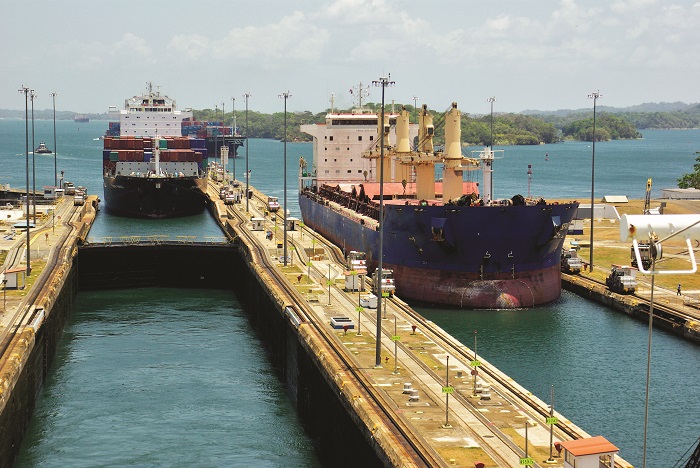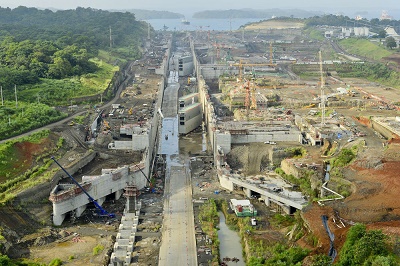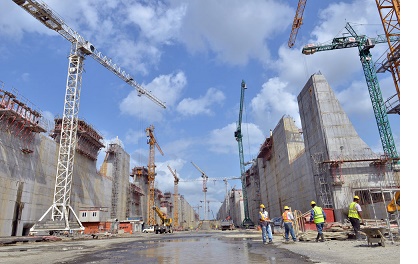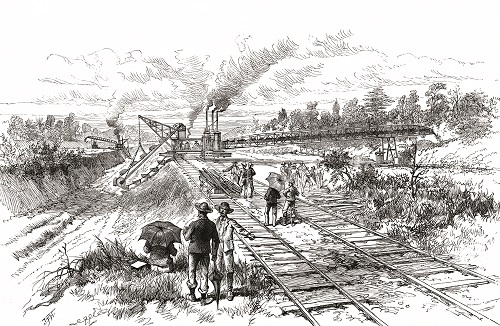Bigger ships will be taking advantage of a bigger Panama Canal when the expansion work is completed next year.

With it will come the new Corozal container terminal for the Pacific end which, when complete, will have a capacity of 5.2 million TEUs, a quay two kilometres long and an alongside depth of 16.3 metres. This will double the size of the current container handling facilities (Hutchinson and PSA) which themselves have announced significant expansion plans. In total this is expected to take the total pacific handling capacity from 4.95 million TEUs/year to around 12 million.
Panama is already established as the largest hub in the Central America/Caribbean region, with an estimated 5.7 million TEU of cargo handled in the country’s ports in 2014. Overall volumes have grown by an average of 12% per annum since 2003, but Panama’s Pacific coast transshipment traffic has outstripped the Atlantic side, growing by nearly 20% per annum in the same period, reaching an estimated 3.1 million TEU in 2014. 
According to Drewry Maritime Research, the Panama Canal Authority expects its Pacific coast container port volumes to reach six million TEU after the expanded canal is opened in 2016, a massive 75% increase on estimated 2014 throughput levels. The timescale for this anticipated increase in demand is not clear though. Drewry estimates, however, that this figure would be reached by around 2024.
In theory the expanded Hutchison and PSA terminals could accommodate six million TEU but adding in Phase 1 of Corozal would give a more comfortable 8.2 million TEU. For the ports on the Pacific coast of Panama, the level of transshipment activity will be driven by the underlying levels of growth in Latin America in particular (along with any changes in liner shipping network patterns). For this sector of the market, other Pacific coast hub ports such as Manzanillo and Lazaro Cardenas (Mexico) and Callao (Peru) will also be vying for a share of the growing market.
 There is also a wild card in the pack as well – the potential Nicaragua Canal which, if built, would inevitably impact on both Panama Canal vessel transits and regional container transshipment activity. The project envisages the construction of two deep water ports, one at each end of the canal – Punta Aguila on the Atlantic side with an intended capacity of 2.6 million TEU/year and Brito on the Pacific coast, with a capacity of two million TEU/year and these would surely have transshipment business in their sights.
There is also a wild card in the pack as well – the potential Nicaragua Canal which, if built, would inevitably impact on both Panama Canal vessel transits and regional container transshipment activity. The project envisages the construction of two deep water ports, one at each end of the canal – Punta Aguila on the Atlantic side with an intended capacity of 2.6 million TEU/year and Brito on the Pacific coast, with a capacity of two million TEU/year and these would surely have transshipment business in their sights.
The maximum size of container ship able to transit the Nicaragua Canal would likely be around 20,000 TEU, significantly higher than the 13-14,000 TEU New Panamax size. The project though remains speculative in the eyes of many observers (despite the recent news that construction work has already commenced), not least because of its US$50 billion+ price tag.
According to Drewry, the expansion of the Panama Canal will trigger growth in regional transshipment activity and Pacific coast ports should be beneficiaries. The timing and phasing of the new Corozal terminal project will need to be carefully judged though – and a close eye will have to be kept on Nicaragua.
The Panama Canal’s largest ever programme of improvements
 The Panama Canal Expansion is the largest project at the canal since its original construction. The project will create a new lane of traffic along the canal through the construction of a new set of locks, doubling the waterway’s capacity. The existing locks allow the passage of vessels that can carry up to 5,000 TEUs. After the expansion the Post-Panamax vessels will be able to transit through the canal, with up to 13,000 TEUs. The expansion will double the canal’s capacity, having a direct impact on economies of scale and international maritime trade.
The Panama Canal Expansion is the largest project at the canal since its original construction. The project will create a new lane of traffic along the canal through the construction of a new set of locks, doubling the waterway’s capacity. The existing locks allow the passage of vessels that can carry up to 5,000 TEUs. After the expansion the Post-Panamax vessels will be able to transit through the canal, with up to 13,000 TEUs. The expansion will double the canal’s capacity, having a direct impact on economies of scale and international maritime trade.
The Program consists of several components:
• New locks (third set of locks);
• Pacific access channel;
• Improvement of navigational channels (dredging);
• Improvements to water supply.
The Panama Canal expansion is based on six years of research, which included more than 100 studies on the economic feasibility, market demand, environmental impact and other technical engineering aspects. Works on the Panama Canal Expansion began on September 2007 at a total cost of US$5.2 billion.
Photos: Top to bottom - The Panama Canal; improvement work underway; dredging being carried out during the canal's construction. Click here to view the next Editor's pick.